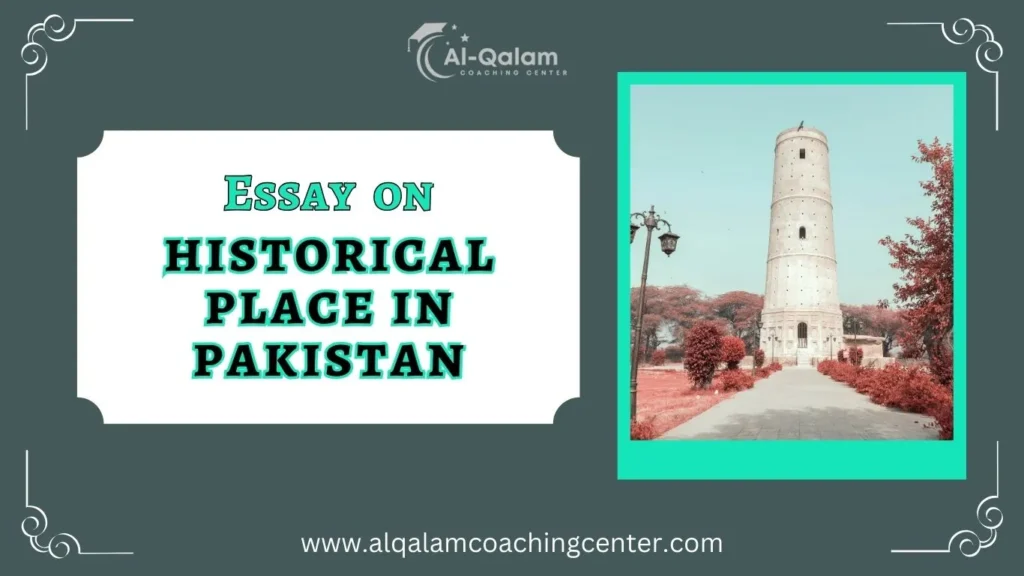Essay on Historical Place in Pakistan (200 & 500 Words)

In this post, I’m excited to share a detailed essay on historical place in Pakistan tailored for school and college students. If you’re searching for well-written English essays on various topics, you’ve come to the right place. You can find English essays, PDF books, and subject notes for Class 9, Class 10, Class 11, and Class 12 by visiting the links below:
I’ve also shared an excellent essay on a visit to a historical place for 2nd-year students. This new essay on historical place in Pakistan provides a thorough explanation of the topic. At Al-Qalm Coaching Center, you’ll discover a range of important English essays designed for Class 10, Class 12, and university students.
Whether you’re gearing up for exams or looking to enhance your understanding of inflation, this essay will be a valuable resource. Keep an eye out for more educational content and helpful resources to support your studies!
Essay on Historical Place in Pakistan
This post is about an Essay on Historical Place in Pakistan for students in Class 10, Class 12, and at the graduation level. It is a crucial essay for their annual English exams. A well-written essay on this topic can help students achieve better grades and enhance their academic standing. You can explore various aspects of a historical place in Pakistan, including its history, architectural features, and cultural significance.
In addition, this essay provides an opportunity to discuss how historical places reflect the rich heritage and diverse history of Pakistan. Students can develop a deeper understanding of Pakistan’s historical and cultural landscape by addressing topics like the historical events associated with the place, its importance in the present day, and its impact on tourism and education. You can also check out related topics such as the preservation of historical sites, the role of historical places in national identity, and the importance of promoting cultural heritage.
Essay on Historical Place in Pakistan: 200 Words
The Lahore Fort, also known as Shahi Qila, is a famous historical place in Pakistan. It is located in the city of Lahore and is a great example of Mughal architecture. The fort was built by Emperor Akbar in the 16th century and later expanded by other Mughal emperors. The fort has many beautiful buildings, gardens, and halls inside its walls.
One of the most famous parts of the Lahore Fort is the Sheesh Mahal, also known as the Palace of Mirrors. The walls and ceilings of this palace are decorated with tiny mirrors that sparkle when light shines on them. Another important part of the fort is the Naulakha Pavilion, which is a beautiful building with intricate decorations and a stunning view of the surrounding area.
The Lahore Fort is not only a symbol of the Mughal era but also a UNESCO World Heritage site. It attracts many tourists from all over the world who come to see its historical beauty and learn about its rich history. Visiting the Lahore Fort is like stepping back in time and experiencing the grandeur of the Mughal Empire.
Essay on Historical Place in Pakistan: 500 Words
The historical city of Mohenjo-Daro, located in the Sindh province of Pakistan, is one of the oldest and most significant archaeological sites in the world. It was one of the major urban centers of the ancient Indus Valley Civilization, which flourished around 2500 BCE. The ruins of Mohenjo-Daro provide a fascinating glimpse into one of the earliest advanced civilizations known to mankind.
Mohenjo-Daro, which means “Mound of the Dead,” was discovered in the 1920s. Surveys revealed a well-planned city with a refined layout. The city was built on a grid pattern, with streets laid out in a precise manner. This advanced planning indicates a high level of social organization and urban planning skills. The city was divided into two main parts: the Citadel and the Lower Town.
The Citadel, located on a raised platform, housed important buildings and was possibly the administrative and religious center of the city. One of the most remarkable structures in the Citadel is the Great Bath. This large, rectangular water tank was made of baked bricks and had a sophisticated drainage system. It is believed to have been used for ritual bathing, reflecting the importance of cleanliness and hygiene in the Indus Valley Civilization.
The Lower Town was the residential area, where people lived and carried out their daily activities. The houses in Mohenjo-Daro were built with baked bricks and had multiple rooms, courtyards, and private wells. The presence of private wells suggests that the inhabitants had access to clean water, a sign of their advanced engineering and understanding of public health.
Another notable feature of Mohenjo-Daro is its complex drainage system. The city had a well-organized network of covered drains and sewers, which carried waste away from the residential areas. This system highlights the importance placed on sanitation and public health by the people of Mohenjo-Daro.
Artifacts found in Mohenjo-Daro include pottery, tools, ornaments, and seals. The seals, often decorated with animal motifs and inscriptions, are particularly intriguing as they suggest a form of writing or symbolic communication. Despite extensive research, the script on these seals remains undeciphered, adding to the mystery of the Indus Valley Civilization.
The city’s economy was based on agriculture, trade, and craft production. The fertile land around Mohenjo-Daro allowed the inhabitants to grow crops such as wheat, barley, and cotton. Trade was facilitated by the city’s strategic location near the Indus River, which connected it to other regions. Evidence of trade with distant lands, including Mesopotamia, has been found, indicating that Mohenjo-Daro was part of an extensive trade network.
Despite its advanced development, Mohenjo-Daro eventually declined and was abandoned around 1900 BCE. The reasons for its decline are still debated, with theories ranging from climate change and natural disasters to invasions by external forces.
Today, Mohenjo-Daro is a UNESCO World Heritage site and a symbol of Pakistan’s rich cultural heritage. It attracts archaeologists, historians, and tourists from around the world who come to marvel at its ancient ruins and learn about the early civilization that once thrived there.
In conclusion, Mohenjo-Daro is a remarkable historical site that offers valuable insights into the Indus Valley Civilization. Its well-planned city layout, advanced engineering, and sophisticated drainage system highlight the achievements of one of the world’s earliest urban centers. The artifacts and ruins of Mohenjo-Daro continue to fascinate and inspire, providing a window into a bygone era and reminding us of the ingenuity and resilience of ancient civilizations.
Related Essays
- Essay On Quaid E Azam
- Essay On A Visit To A Historical Place
- Essay On Corruption
- Essay On My Favourite Personality
- Essay On Our Country Pakistan
- Essay On Justice
- Essay On Environment
- Essay On Abdul Sattar Edhi
- Essay On Sports And Games
- Essay On Global Warming
- Essay On Poverty
- Essay On Labour Day

Hina Khalil
Hina Khalil is a writer with a passion for creativity and storytelling. She contributes essays to the Al-Qalam Coaching Center, drawing on her deep interest in history, politics and social issues. An avid reader, Hina brings a unique perspective to her work, blending her love for literature with a keen awareness of the world around her.
